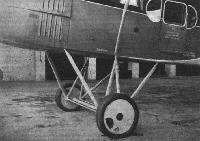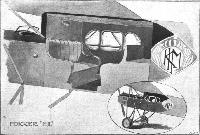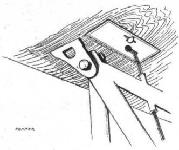
Описание
Страна : Нидерланды
Год : 1919
Транспортный самолет с экипажем из одного человека
Варианты
- Fokker - F.I / F.II - 1919 - Нидерланды
- Hopfner - HV.3/27 - 1927 - Австрия
Fokker F.I и F.II
Первым коммерческим самолетом, разработанным Рейнхольдом Платцем, стал моноплан F.I с открытой кабиной для летчика и пассажира. Понимая необходимость увеличения пассажировместимости, Платц отказался от дальнейших работ по F.I и приступил к проектированию усовершенствованного самолета F.II. Как и F.I (прототип которого имел обозначение V.44), F.II (V.45) был построен на заводе "Fokker" в германском Шверине. Он совершил первый полет в октябре 1919 года. После того, как Энтони Фоккер решил перевести свой бизнес из Германии в родную Голландию, прототип F.II нелегально вылетел из Германии 20 марта 1920 года.
F.II был одним из первых специализированных транспортных пассажирских самолетов в мире. Были построены 30 таких самолетов, большей частью по лицензии германской фирмой "Grulich". Некоторое количество также было выпущено Нидерландским авиационным заводом на севере Амстердама и новым заводом "Fokker" в Веере. Предполагается, что еще три машины были изготовлены в Шверине.
Свободнонесущее крыло с относительно толстым профилем и фанерной обшивкой, первоначально разработанное для F.I, болтами крепилось прямо к верху фюзеляжа F.II, имевшему прямоугольное сечение. Киль отсутствовал, а руль направления был относительно небольшой площади. Четыре пассажира размещались в закрытой кабине под крылом, а пятый пассажир и пилот сидели в открытой кабине перед передней кромкой. Шасси было выполнено по схеме с хвостовым костылем, основные стойки имели резиновую амортизацию.
Самолеты Fokker-Grulich F.II, которых построили как минимум 19 штук, отличались улучшенной компоновкой кабины, окнами новой формы и усиленным шасси. Инженер Карл Грулич был техническим директором "Deutsche Aero Lloyd", и эта авиакомпания использовала его вариант F.II. Крыло Grulich F.II строилось фирмой "Albatros", а фюзеляж - фирмой DAL, которая также производила окончательную сборку.
F.II, построенные в Веере и Шверине, оснащались двигателями BMW IIIa, а на вариант Grulich F.II устанавливали двигатели BMW IV, развивавшие 250 л.с. (186 кВт). Правда, позднее большинство из них переоснастили двигателями BMW Va мощностью 320 л.с. (239 кВт), присвоив обозначение F.IIb. Построенные в Шверине F.II были зарегистрированы в вольном городе Данциге и использовались авиакомпанией "Deutsche Luftreederei". F.II голландской постройки в 1920-1927 годы использовались национальным авиаперевозчиком KLM, а еще два самолета были проданы бельгийской авиакомпании "SABENA" и работали на линии Брюссель - Антверпен. Один голландский F.II был оснащен двигателем Armstrong Siddeley Puma в 240 л.с. (179 кВт), а еще одна машина недолгое время летала с двигателем BMW IV.
Дольше всех прослужили самолеты Fokker-Grulich F.IIb: некоторое количество таких машин получила в 1926 году вновь организованная авиакомпания "Deutsche Lufthansa", еще в 1934 году использовавшая 10 F.II на местных линиях между Кельном и Аахеном, Эссеном, Крефельдом и Мюльхаймом в Руре.
ТАКТИКО-ТЕХНИЧЕСКИЕ ХАРАКТЕРИСТИКИ
Fokker F.II
Тип: транспортный самолет с экипажем из одного человека
Силовая установка: один рядный двигатель BMW IIIa мощностью 185 л. с. (138 кВт)
Летные характеристики: макс. скорость у земли 150 км/ч; крейсерская скорость на оптимальной высоте 120 км/ч; дальность полета 1200 км
Масса: пустого 1200 кг; максимальная взлетная 1900 кг
Размеры: размах крыла 16,10 м; длина 11,65 м; высота 3,20 м; площадь крыла 38,20 м2
Полезная нагрузка: до пяти пассажиров, четверо в закрытой кабине и один в открытой рядом с пилотом
Описание:
- Fokker F.I и F.II
- Flight, August 1920
A FOKKER SIX-SEATER LIMOUSINE MONOPLANE - Flight, October 1920
A FOKKER RAID ON LONDON
Фотографии
-
Мировая Авиация 135
Регистрационный номер: H-NABD [3] Рассказывали, что при сильном встречном ветре пилоты авиакомпании KLM, заметив попутный поезд, старались занять положение точно над ним, чтобы пассажиры F.II не заметили, что скорость самолета значительно меньше скорости поезда. После службы в KLM самолет HNABD летал в бельгийской авиакомпании "SABENA".
-
Flight 1920-08 / Flight
The Fokker V-45 passenger machine
-
Flight 1920-08 / Flight
Three-quarter front view of the Fokker V-45
-
Jane's All the World Aircraft 1980 / Encyclopedia of Aviation - 1. Chronology
Регистрационный номер: H-NABC [3] Fokker F.II of KLM (7 October 1919).
-
Aeroplane Monthly 1985-09 / J.Stroud - Wings of Peace
Регистрационный номер: H-NABC [3] The prototype Fokker F.II after being fitted with the Puma engine.
-
Aeroplane Monthly 1985-09 / J.Stroud - Wings of Peace
Регистрационный номер: H-NABD [3] H-NABD, in early KLM livery, was the third F.II. Here it has the original BMW IIIa engine.
-
Flight 1920-10 / Flight
Регистрационный номер: H-NABD [3] THE FOKKER F.II AT WADDON: Three-quarter front view
-
Flight 1920-10 / Flight
The Fokker F.II at Waddon: View of the undercarriage
-
Aeroplane Monthly 1985-09 / J.Stroud - Wings of Peace
Регистрационный номер: D-717 Фюзеляж F.II имел конструкцию из стальных труб с полотняной обшивкой и постепенно сужался к месту крепления горизонтального оперения, подкрепленного подкосами.
Luft Hansa's Fokker-Grulich F.II D-717. In the background is an F.III.Другие самолёты на фотографии: Fokker F.III - Нидерланды - 1921
-
Aeroplane Monthly 1976-04 / H.Seabrook-Smith - Lufthansa 1926-76 (1)
Регистрационный номер: D-756 [2] Голландский авиаконструктор и предприниматель Энтони Фоккер быстро понял, что на одних военных заказах в уставшей от мировой бойни Европе не проживешь, и потому вскоре разработал пассажирский самолет F.II.
Fokker-Grulich F.II D-756 Dievenow had a BMW IV engine. DLH took over 19 F.IIs in 1926 and named them after German rivers. One of them also served as a crop-duster. -
Aeroplane Monthly 1985-09 / J.Stroud - Wings of Peace
Регистрационный номер: D-756 [2] The Fokker-Grulich F.II D-756 in Luft Hansa service, with BMW IV.
-
Flight 1920-10 / Flight
THE FOKKER "F.II" AT WADDON: View of the cabin arrangement
-
Aeroplane Monthly 1985-09 / J.Stroud - Wings of Peace
Регистрационный номер: H-NABC [3] KEITH WOODCOCK'S painting shows the prototype Fokker F.II, with BMW IIIa engine, in early KLM livery.
-
Flight 1920-10 / Flight
THE FOKKER "F.II": The wings are attached to the body by four bolts only, two at the top of the struts and two on the top longerons of the fuselage
-
Flight 1920-10 / Flight
The Fokker "F.II": Sketch showing the ball-and-socket joint of undercarriage strut to lower longeron
-
Flight 1920-10 / Flight
THE FOKKER "F.II": Details of the undercarriage
-
Flight 1920-08 / Flight
A Fokker passenger-carrying monoplane, 185 h.p. B.M.W. engine. General arrangement, sketch
- Фотографии

















